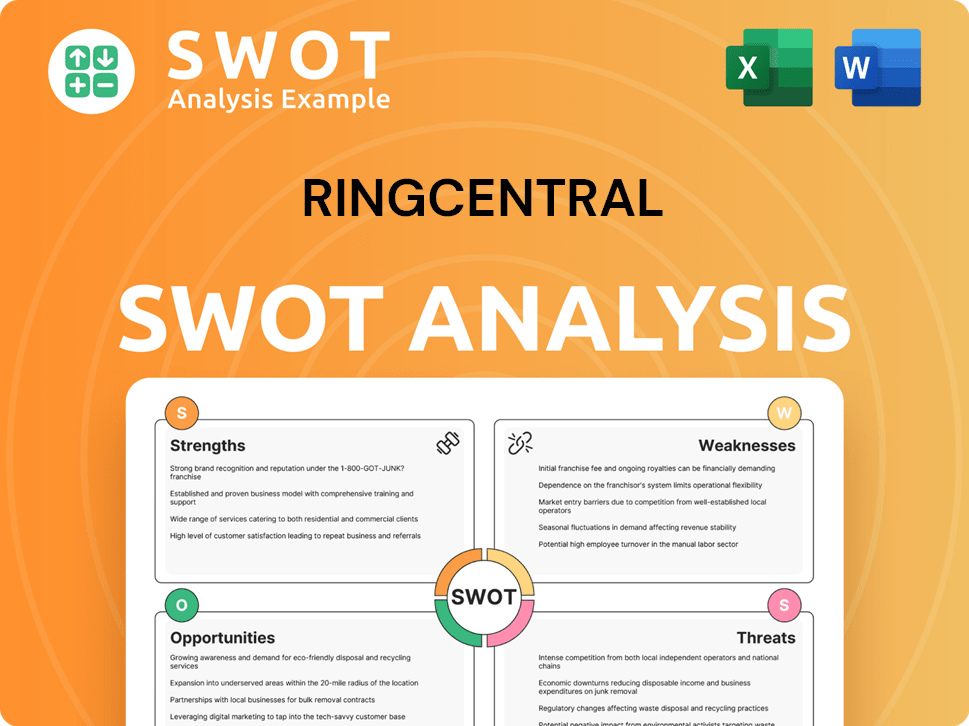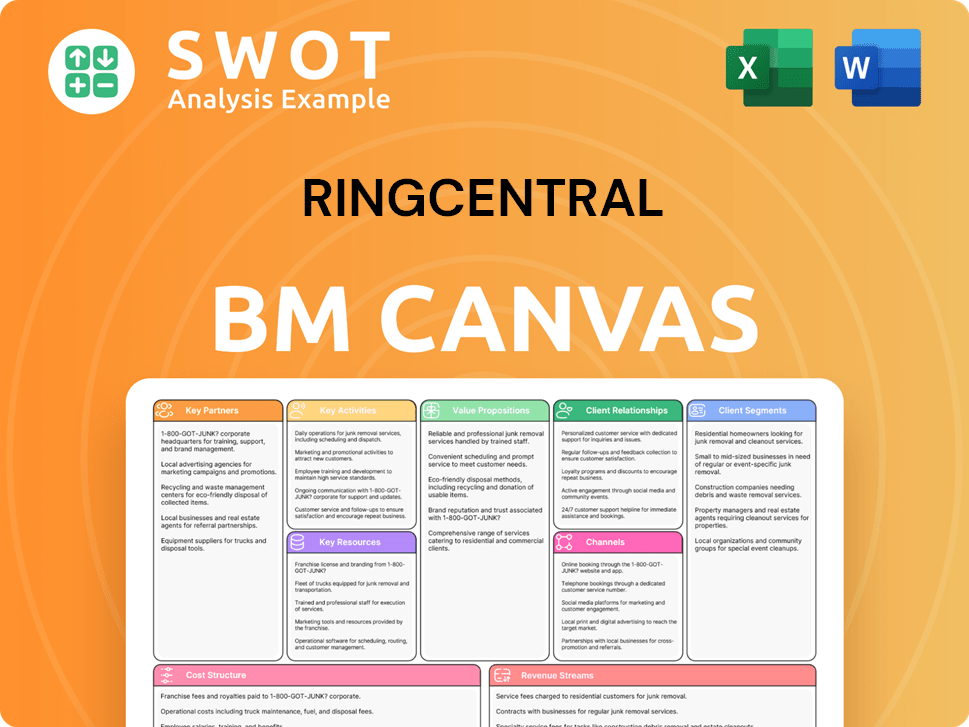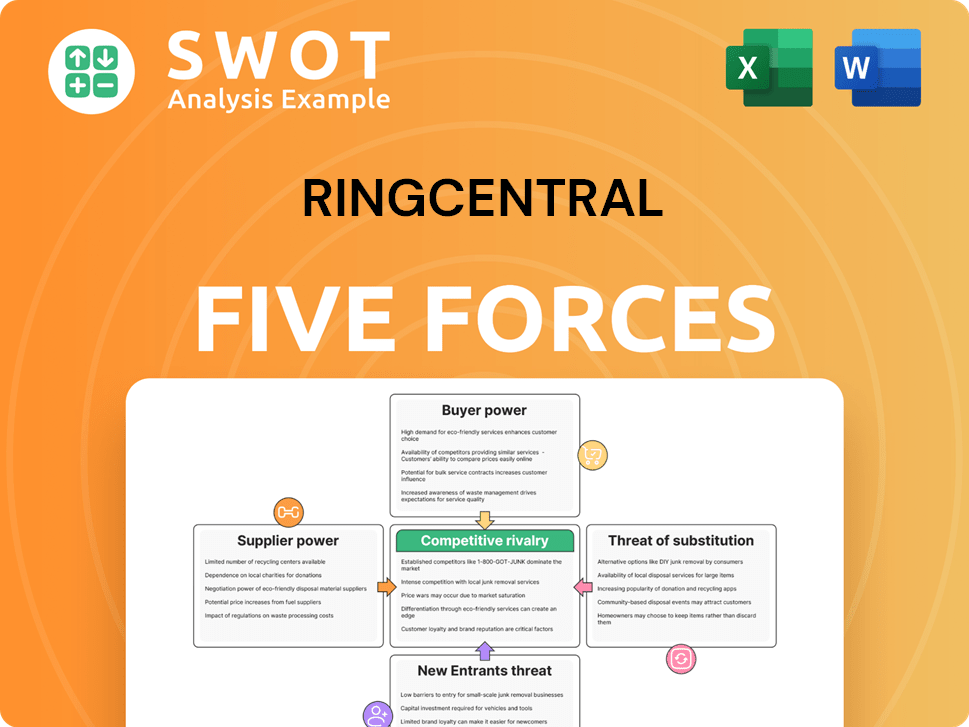RingCentral Bundle
Who Does RingCentral Serve? Unveiling the Customer Demographics!
In the dynamic world of business communication, understanding customer demographics and target markets is crucial for success. RingCentral, a leader in AI-powered communication solutions, has masterfully navigated this landscape. From its inception in 1999 to its current status as a Unified Communications as a Service (UCaaS) giant, RingCentral's evolution showcases a deep understanding of its customer base and their needs.

RingCentral's strategic focus on its RingCentral SWOT Analysis has allowed it to expand its customer base and achieve significant financial success. The company's growth, with impressive revenue figures in 2024, underscores the importance of a well-defined customer strategy. This analysis will explore the specific customer demographics, the RingCentral target market, and the evolving needs of businesses that rely on cloud phone system and VoIP services for seamless business communication.
Who Are RingCentral’s Main Customers?
Understanding the customer demographics and target market of RingCentral is crucial for grasping its business strategy. The company primarily focuses on the business-to-business (B2B) sector, offering cloud-based communication solutions. This focus allows RingCentral to tailor its services to the specific needs of various business sizes and industries.
RingCentral's customer profile encompasses a wide range of organizations, from small and medium-sized businesses (SMBs) to large enterprises and Fortune 1000 companies. Its cloud phone system and VoIP services are designed to be scalable and adaptable. This approach enables RingCentral to capture a significant portion of the market by catering to diverse communication needs.
The company's revenue streams are diversified across different business segments, with a notable emphasis on enterprise clients. For example, in Q3 2024, Enterprise ARR (Annual Recurring Revenue) increased by 11% year-over-year, reaching $1.07 billion. This growth underscores the company's success in securing large deals, such as a 40,000-seat agreement with a Fortune 500 retailer in Q1 2024.
RingCentral segments its customer base based on business size and communication needs. The Core plan at $20 per user/month is designed for SMBs. The Advanced plan, priced at $25 per user/month, caters to growing mid-market companies. The Ultra plan, at $35 per user/month, is tailored for enterprises requiring advanced features.
A key aspect of RingCentral's strategy involves integrating AI into its solutions. This approach has expanded its total addressable market. Solutions like RingCX (contact center) and RingSense (sales intelligence) attract new customer segments. This focus has led to the acquisition of over 700 business customers for RingCX by the end of Q4 2024.
The adoption of AI-powered solutions has significantly boosted RingCentral's customer base. RingSense has attracted over 2,000 customers, showing a sequential increase of over 65%. RingCentral Events also contributes with approximately 700 accounts as of Q4 2024. This expansion demonstrates the company's ability to attract customers seeking advanced communication tools.
- RingCentral's focus on business communication solutions caters to a broad range of customer needs.
- The company's growth strategy is driven by a multi-product approach, including AI-powered tools.
- The customer demographics and target market are diverse, spanning SMBs to large enterprises.
- For further insights, consider exploring the Growth Strategy of RingCentral.
RingCentral SWOT Analysis
- Complete SWOT Breakdown
- Fully Customizable
- Editable in Excel & Word
- Professional Formatting
- Investor-Ready Format

What Do RingCentral’s Customers Want?
Understanding the customer needs and preferences is crucial for any business, and this is especially true for companies providing business communication solutions. The customer demographics of RingCentral and its target market are defined by specific needs for efficient, unified, and intelligent communication and collaboration tools. These needs drive purchasing decisions, influencing factors such as cost-effectiveness, scalability, ease of use, and advanced features that boost productivity and customer satisfaction.
Businesses seek solutions that streamline operations, improve internal and external communication, and offer a seamless experience across various channels. The psychological, practical, and aspirational drivers for choosing RingCentral's offerings include the desire for increased employee productivity, reduced app toggling, and improved access to resources and information. This focus on efficiency and user experience shapes the customer profile and informs the company's product development and marketing strategies.
The company's approach to product development is heavily influenced by customer feedback and market trends, ensuring that its solutions meet the evolving needs of its target market. For example, the rapid innovation and traction of RingCX, its AI-first contact center solution, demonstrates a direct response to the increasing demand for deeply integrated UCaaS and CCaaS solutions. This responsiveness is key to maintaining a strong customer base and competitive advantage.
The primary needs driving customers include the need for cost-effective, scalable, and easy-to-use communication solutions. Businesses also prioritize features that enhance productivity and customer satisfaction. RingCentral's focus on these areas helps it meet the demands of its target market.
- Cost-Effectiveness: Businesses always seek solutions that provide value for their investment, especially small to medium-sized businesses (SMBs).
- Scalability: The ability to easily scale communication systems as a business grows is crucial.
- Ease of Use: Simple, intuitive interfaces and user experiences are highly valued to reduce training and increase adoption.
- Advanced Features: Features like AI-powered tools and integrations with other business applications are increasingly important.
RingCentral addresses common pain points associated with legacy communication systems. These include issues such as poor call quality, dropped calls, limited flexibility, and disjointed workflows. By focusing on these areas, the company provides solutions that improve overall business communication.
- Legacy System Limitations: Outdated systems often struggle to keep pace with growing demands.
- Poor Call Quality: Ensuring clear and reliable communication is essential for business operations.
- Limited Flexibility: The need for flexible solutions that adapt to changing business needs.
- Disjointed Workflows: Integrating communication with other business tools to streamline processes.
The company's customer base is diverse, with a focus on businesses of all sizes, from SMBs to large enterprises. The ideal customer profile includes organizations that prioritize efficient communication, collaboration, and customer experience. For a deeper dive into the company's origins, consider reading the Brief History of RingCentral.
RingCentral actively uses customer feedback and market trends to drive product development. The introduction of new features and solutions is a direct response to the evolving needs of its customer base. This responsiveness helps the company stay competitive and meet the demands of its target market.
- AI-Powered Solutions: The development of AI-driven features like RingCentral AI Receptionist (AIR) addresses the need for automated call handling and routing.
- Focus on Sales Productivity: Offerings like RingSense for Sales enhance sales productivity by analyzing interactions.
- Integration of UCaaS and CCaaS: The integration of UCaaS and CCaaS solutions to drive superior employee and customer experiences.
The company's marketing and product features are tailored to specific market segments. For example, the introduction of RingCentral AI Receptionist (AIR) in late 2024 and early 2025, a generative AI phone agent integrated into the phone system, addresses the need for automated call handling and routing, freeing up human agents' time. This innovation caters to businesses looking to optimize operational efficiency and augment their workforce with digital employees. The company's focus on customer satisfaction is evident in its efforts to improve employee productivity, with users reporting a 31% increase, and significant improvements in access to resources (23%) and information (27%), according to a recent RingCentral Customer Success Metrics Survey.
RingCentral PESTLE Analysis
- Covers All 6 PESTLE Categories
- No Research Needed – Save Hours of Work
- Built by Experts, Trusted by Consultants
- Instant Download, Ready to Use
- 100% Editable, Fully Customizable

Where does RingCentral operate?
The company, a prominent player in the business communication sector, boasts a significant global footprint. It serves over 400,000 organizations and approximately seven million end-users worldwide, indicating a broad customer base. While specific market share breakdowns by region aren't extensively publicized, the company's strategic initiatives and financial reporting provide insights into its geographical focus.
The United States serves as a primary market for the company, as evidenced by financial reporting in USD and references to US-based operations and customer examples. This suggests a strong concentration of customers and operations within the US market. The company's approach to customer acquisition and retention is likely tailored to the US market, reflecting its importance in the overall business strategy.
The company's geographical reach is also expanded through strategic partnerships. It collaborates with major global service providers. For instance, a joint offering with Zayo, 'Zayo UC+ with RingCentral,' combines Zayo's network infrastructure with the company's solutions, indicating a focus on leveraging telecommunications partners for broader market penetration. Furthermore, its expansion into emerging markets is demonstrated by its licensed availability across all 22 telecom circles in India for its RingEX and RingCX solutions, through a partnership with Genpact.
The company leverages strategic partnerships to broaden its market reach. These collaborations are vital for expanding its geographical footprint. These partnerships enable the company to offer its services more effectively in various regions.
The company utilizes an extensive channel partner program to localize its offerings and marketing efforts. This program includes over 4,000 partners worldwide, encompassing resellers and technology partners. This network helps the company adapt to regional preferences and effectively reach new markets.
The company maintains a strong global presence, serving over 400,000 organizations worldwide. This extensive reach indicates a diversified customer base across various geographical regions. Its ability to serve a large number of customers globally highlights its robust infrastructure and service capabilities.
The company strategically expands into emerging markets, such as India. Its licensed availability across all 22 telecom circles in India for its RingEX and RingCX solutions demonstrates its commitment to these markets. This expansion is facilitated through partnerships, such as the one with Genpact.
The channel partner program provides localized sales and support. This approach inherently addresses variations in customer demographics, preferences, and buying power across different regions. Localized support ensures that the company meets the specific needs of its customers in various markets.
The acquisition of Hopin Events and Sessions in August 2023, rebranded as RingCentral Events, bolstered its capabilities for virtual events globally. This move indicates an adaptation to the hybrid work environment and its associated geographic flexibility. This acquisition enhances the company's ability to serve customers worldwide.
The company's geographical market presence is substantial, with a strong focus on the United States and strategic expansions through partnerships and channel programs. The company's ability to adapt to regional preferences and provide localized support is crucial for its global success. For more insights into the company's business model, see the article Revenue Streams & Business Model of RingCentral.
- The company serves over 400,000 organizations worldwide.
- Strategic partnerships are key to expanding its global reach.
- The channel partner program supports localized sales and support.
- The company has expanded into emerging markets like India.
RingCentral Business Model Canvas
- Complete 9-Block Business Model Canvas
- Effortlessly Communicate Your Business Strategy
- Investor-Ready BMC Format
- 100% Editable and Customizable
- Clear and Structured Layout

How Does RingCentral Win & Keep Customers?
The approach to customer acquisition and retention at [Company Name] is multifaceted, integrating various marketing strategies, sales tactics, and customer-centric initiatives. A significant portion of their online traffic, nearly 80%, comes directly, indicating strong brand recognition and customer loyalty. They also attract around 1 million monthly visitors globally through organic search, which is just under 12% of their total online traffic.
Key strategies include digital marketing campaigns on platforms like LinkedIn, Twitter, and Facebook. In 2022, the company reportedly invested around $100 million in digital marketing to boost visibility and customer engagement. Content marketing is also a key competitive advantage, positioning [Company Name] as a thought leader in the UCaaS space. They produce high-quality content that addresses the needs of their target audience. They also use video content to showcase features like RingCentral Events and RingCX.
Sales tactics involve a product-led growth (PLG) strategy for products like RingCentral Events, allowing prospects to explore the product without sales consultation, and a sales-led growth (SLG) strategy that offers personalized demonstrations and post-purchase support. They actively participate in industry events like CEMA Summit and HubSpot Inbound to generate leads.
Heavy focus on social media platforms such as LinkedIn, Twitter, and Facebook. A significant portion of the marketing budget is allocated to digital channels. This helps in enhancing brand visibility and customer engagement.
Positions [Company Name] as a thought leader in the UCaaS space. Produces high-quality, informative content that addresses the needs of the target audience. Utilizes video content to showcase features like RingCentral Events and RingCX.
Employs a PLG strategy for products like RingCentral Events. Allows potential customers to explore the product without needing a sales consultation. This approach lowers the barrier to entry and encourages trial.
Offers personalized demonstrations and post-purchase support. Provides tailored sales experiences to meet specific customer needs. This strategy ensures customer satisfaction and retention.
Customer retention strategies are deeply embedded in product development and customer success initiatives. The integration of AI into their product portfolio is a significant retention driver, enhancing functionality and user productivity. New AI-powered products like RingCX and RingSense are projected to drive $100 million in Annualized Recurring Revenue (ARR) by the end of 2025, partly by increasing the 'stickiness' of their platform and improving customer retention. [Company Name] also emphasizes strong customer service, providing comprehensive support options including self-service knowledge bases, chat support, and 24/7 live event support. They also offer dedicated customer success managers, onboarding, and training. The company uses customer data and analytics to understand user behavior, identify pain points, and make data-driven decisions for product improvements, which directly impacts user adoption and retention. Successful acquisition campaigns and retention initiatives often highlight how [Company Name]'s solutions help businesses improve first-response times, increase customer satisfaction, and gain insights into customer needs through AI-powered analytics. To further understand the competitive landscape and how [Company Name] stacks up against its rivals, take a look at the Competitors Landscape of RingCentral.
AI enhances functionality and user productivity. New AI-powered products like RingCX and RingSense are projected to drive $100 million in ARR by the end of 2025. This increases platform 'stickiness' and improves customer retention.
Provides comprehensive support options including self-service knowledge bases, chat support, and 24/7 live event support. Offers dedicated customer success managers, onboarding, and training. Emphasizes strong customer service to ensure satisfaction.
Uses customer data and analytics to understand user behavior and identify pain points. Makes data-driven decisions for product improvements, which directly impacts user adoption and retention. Focuses on continuous improvement based on customer feedback.
Offers dedicated customer success managers. Provides onboarding and training programs. Ensures customers get the most out of the services.
Customer retention strategies are deeply embedded in product development. Focuses on enhancing functionality and user productivity. Leverages AI to drive innovation and customer satisfaction.
Focuses on how solutions help businesses improve first-response times. Highlights increased customer satisfaction and gains insights into customer needs through AI-powered analytics. Showcases the value of the services provided.
RingCentral Porter's Five Forces Analysis
- Covers All 5 Competitive Forces in Detail
- Structured for Consultants, Students, and Founders
- 100% Editable in Microsoft Word & Excel
- Instant Digital Download – Use Immediately
- Compatible with Mac & PC – Fully Unlocked

Related Blogs
- What are Mission Vision & Core Values of RingCentral Company?
- What is Competitive Landscape of RingCentral Company?
- What is Growth Strategy and Future Prospects of RingCentral Company?
- How Does RingCentral Company Work?
- What is Sales and Marketing Strategy of RingCentral Company?
- What is Brief History of RingCentral Company?
- Who Owns RingCentral Company?
Disclaimer
All information, articles, and product details provided on this website are for general informational and educational purposes only. We do not claim any ownership over, nor do we intend to infringe upon, any trademarks, copyrights, logos, brand names, or other intellectual property mentioned or depicted on this site. Such intellectual property remains the property of its respective owners, and any references here are made solely for identification or informational purposes, without implying any affiliation, endorsement, or partnership.
We make no representations or warranties, express or implied, regarding the accuracy, completeness, or suitability of any content or products presented. Nothing on this website should be construed as legal, tax, investment, financial, medical, or other professional advice. In addition, no part of this site—including articles or product references—constitutes a solicitation, recommendation, endorsement, advertisement, or offer to buy or sell any securities, franchises, or other financial instruments, particularly in jurisdictions where such activity would be unlawful.
All content is of a general nature and may not address the specific circumstances of any individual or entity. It is not a substitute for professional advice or services. Any actions you take based on the information provided here are strictly at your own risk. You accept full responsibility for any decisions or outcomes arising from your use of this website and agree to release us from any liability in connection with your use of, or reliance upon, the content or products found herein.